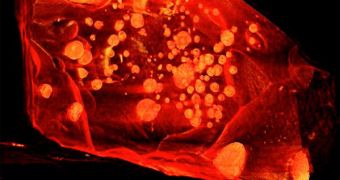A group of investigators at the Stanford University and the SLAC National Accelerator Laboratory is developing a new technique of producing highly-detailed, three-dimensional images of minute samples of material. The method works under extreme pressure conditions as well.
The new effort, which experts believe could lead to a wide range of new experiments, can be used to gain more insight into how our planet's core appeared and developed after Earth originally coalesced.
According to the earliest results of the investigation, it would appear that one of the conditions until now though to be necessary for the development of a core may not play such an important role after all.
Simply put, Earth did not have to be entirely molten in order for its iron core to readily separate from the rocky layers the continents and oceans lie on, called the crust.
The new observations method being investigated at SLAC is called high-pressure nanoscale X-ray computed tomography (HPNXCT). Details of how it works were presented at a scientific conference.
The 2010 annual fall meeting of the American Geophysical Union (AGU) is currently being held in San Francisco, and the new work was presented there on Thursday, December 16.
According to Stanford mineral physicist Wendy Mao, the most pressing issues can be resolved by looking at their smallest details. This is the approach the research group is taking in understanding how Earth's core formed.
This is one of few major events to take place in our planet's interior. Using HPNXCT, the team was able to determine how small amounts of chemicals such as iron and silicate minerals interacted at ultra-high pressures and temperatures.
These were the conditions the core developed and separated in, some 4.5 billion years ago. The event took place over millions of years, a short while after the planet began coalescing from the Sun's protoplanetary disk.
“It is pretty exciting, being able to measure the interactions of iron and silicate materials at very high pressures and temperatures, which you could not do before,” explains Mao.
“No one has ever imaged these sorts of changes at these very high pressures,” adds the expert, who holds an appointment as an assistant professor of geological and environmental sciences, and of photon science at the university.
“At high pressure, the iron takes a more elongate, platelet-like form. So it looks like you could get some percolation of iron at high pressure. If iron could do that, that would tell you something really significant about the thermal history of the Earth,” she adds.
“We have some interesting results, but it is the kind of measurement that you need to repeat a couple times to make sure,” the researcher concludes.

 14 DAY TRIAL //
14 DAY TRIAL //